GlacialTech Alaska - a breath of cold air
Founded in June 2001 in Taiwan, GlacialTech is fairly well known in the air cooling market. Releasing completely inexpensive coolers, which successfully outperformed boxed CPU coolers in performance, GlacialTech gained popularity among economical users, for whom the price-performance ratio is higher than the phenomenal efficiency for a frantic cost. However, the recent announcement of two representatives of the family of high-performance coolers Alaska and Siberia indicates the company's desire to develop this direction. One of these coolers, called Alaska - the largest and northern state of the United States, was in our laboratory.
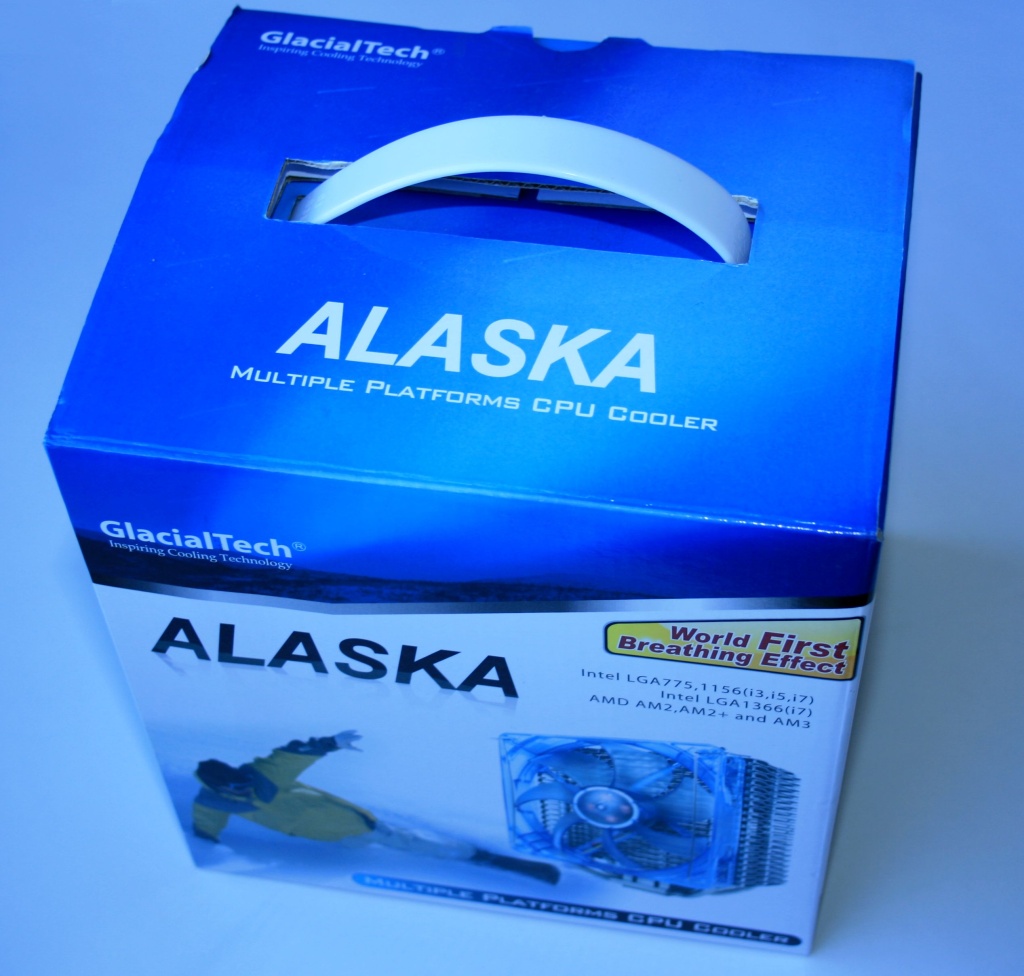
GlacialTech Alaska CPU cooler comes in a cardboard box made with white and blue colors, equipped with a plastic handle for easy carrying.
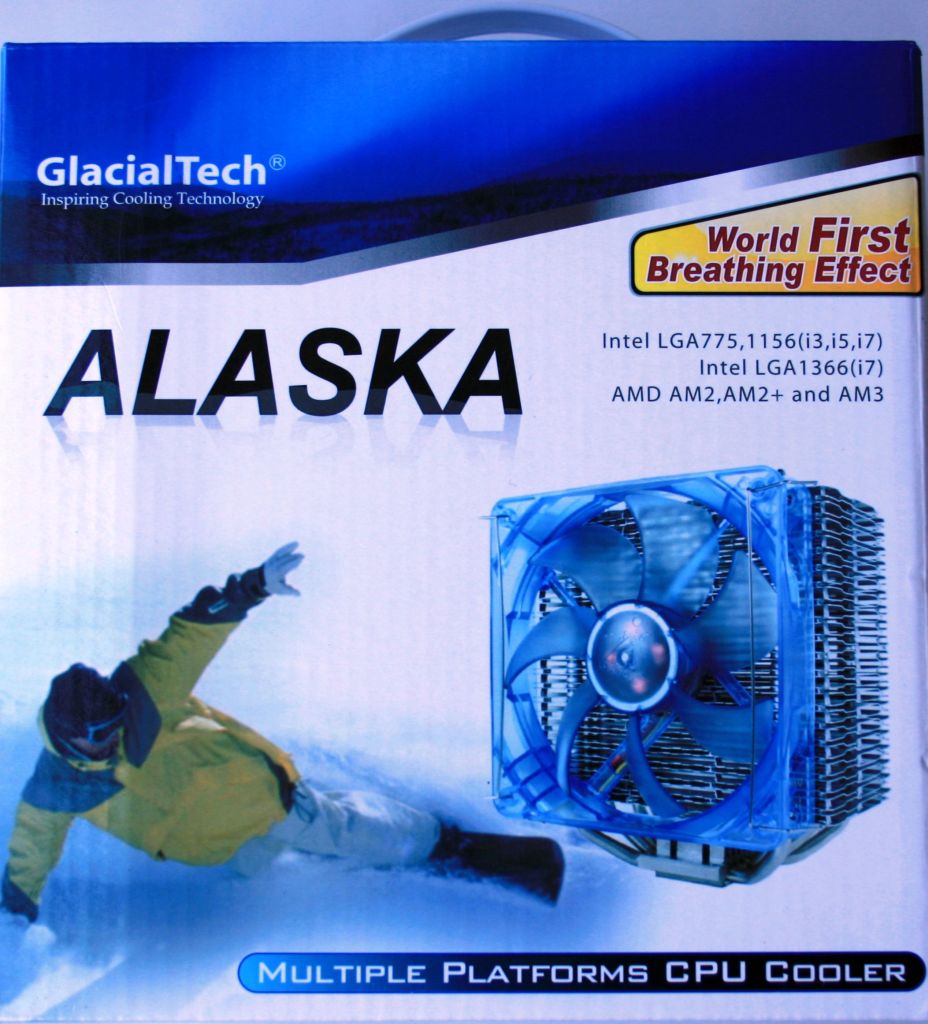
On the front side of which there is an image of the cooler itself, a snowboarder symbolizing power and cold, as well as information about compatible platforms Intel LGA 775/1156/1366 and AMD AM2 / AM2 + / AM3.
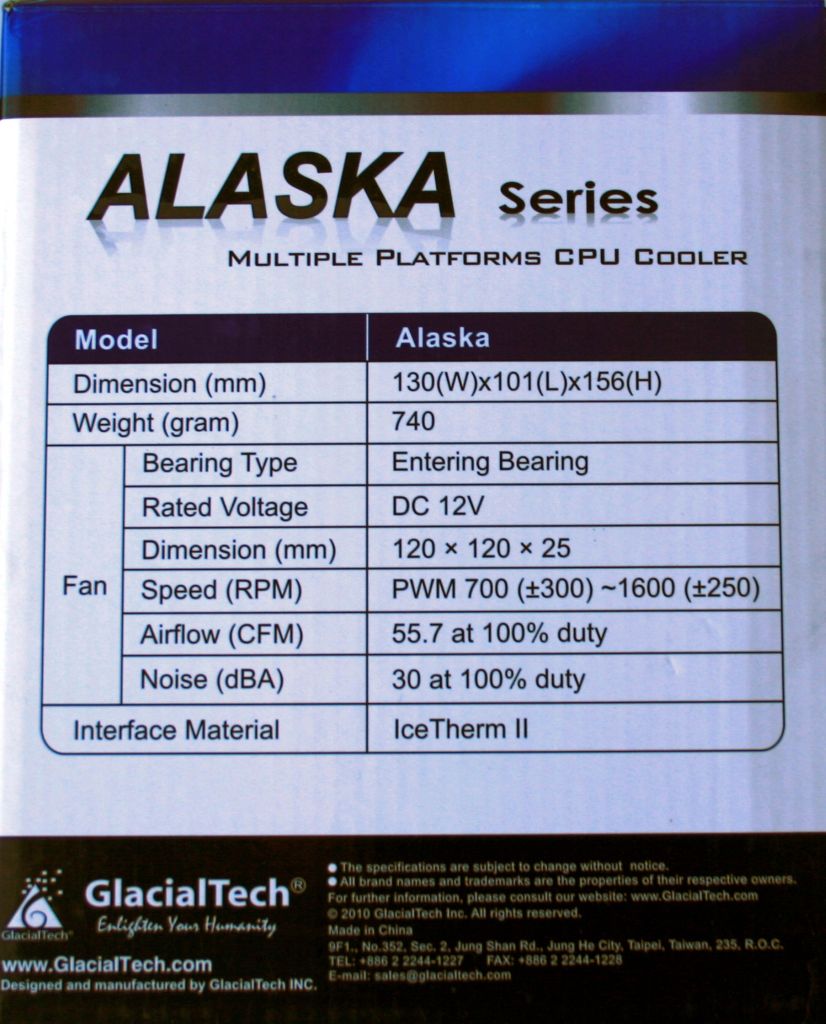

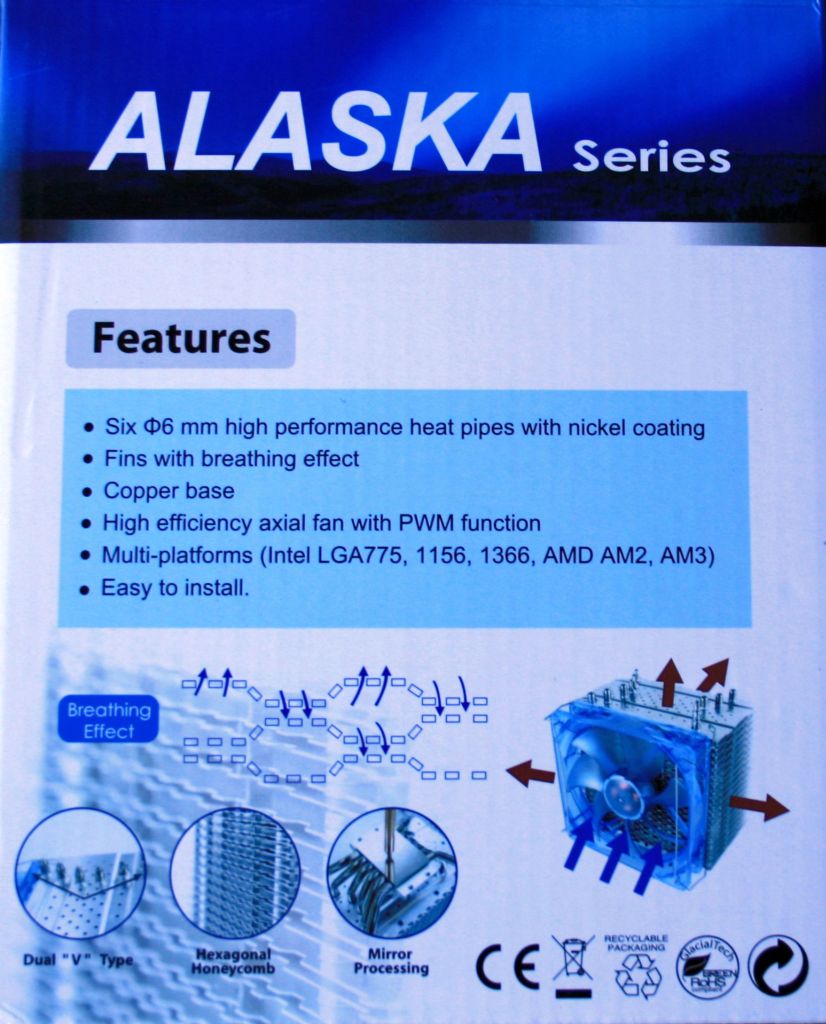
On the side walls of the box and its back side, there is information about the technical characteristics, key features of the cooler and a list of contacts with the manufacturer. Also, this information can be found on the official website of the company GlacialTech.
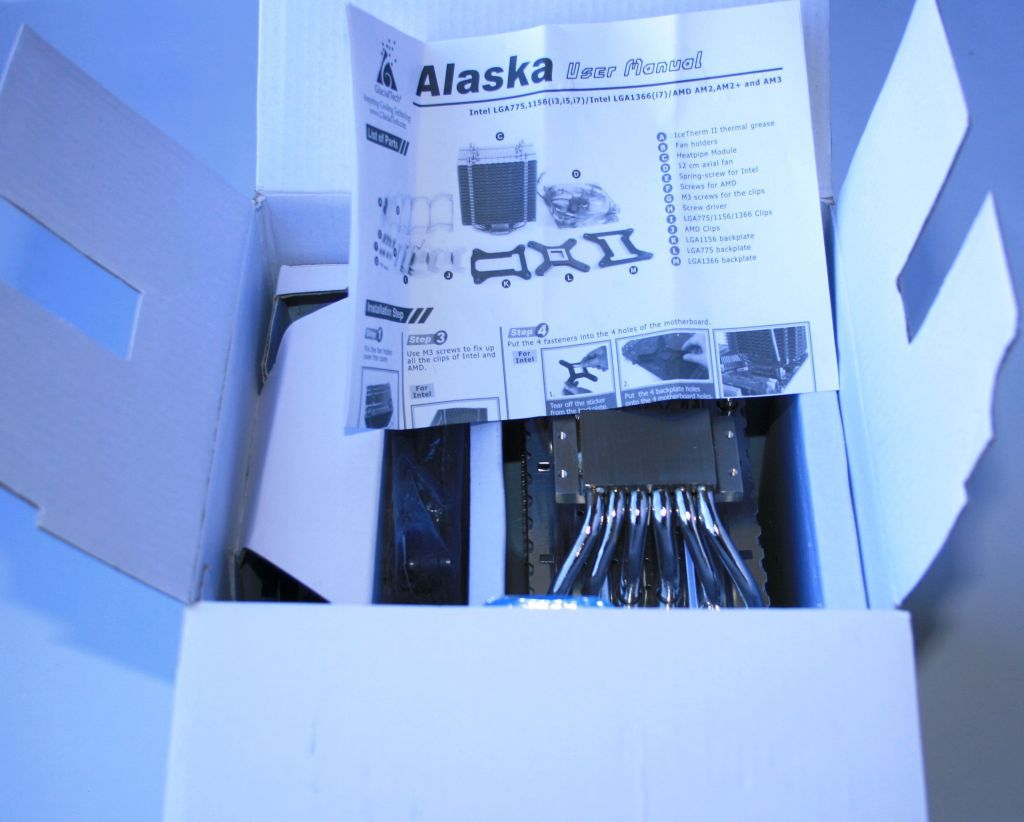
Inside the packing box, we find a radiator, a set of fasteners in a separate plastic bag, a fan in a small additional box and installation instructions. All components are fixed securely and problems during transportation should not arise.

The radiator has dimensions of 130 x 101 x 156 mm. Its weight is 740 grams. The “body” of the radiator is based on six copper nickel-plated heat pipes with a diameter of 6 mm, on which 40 aluminum plates are strung.
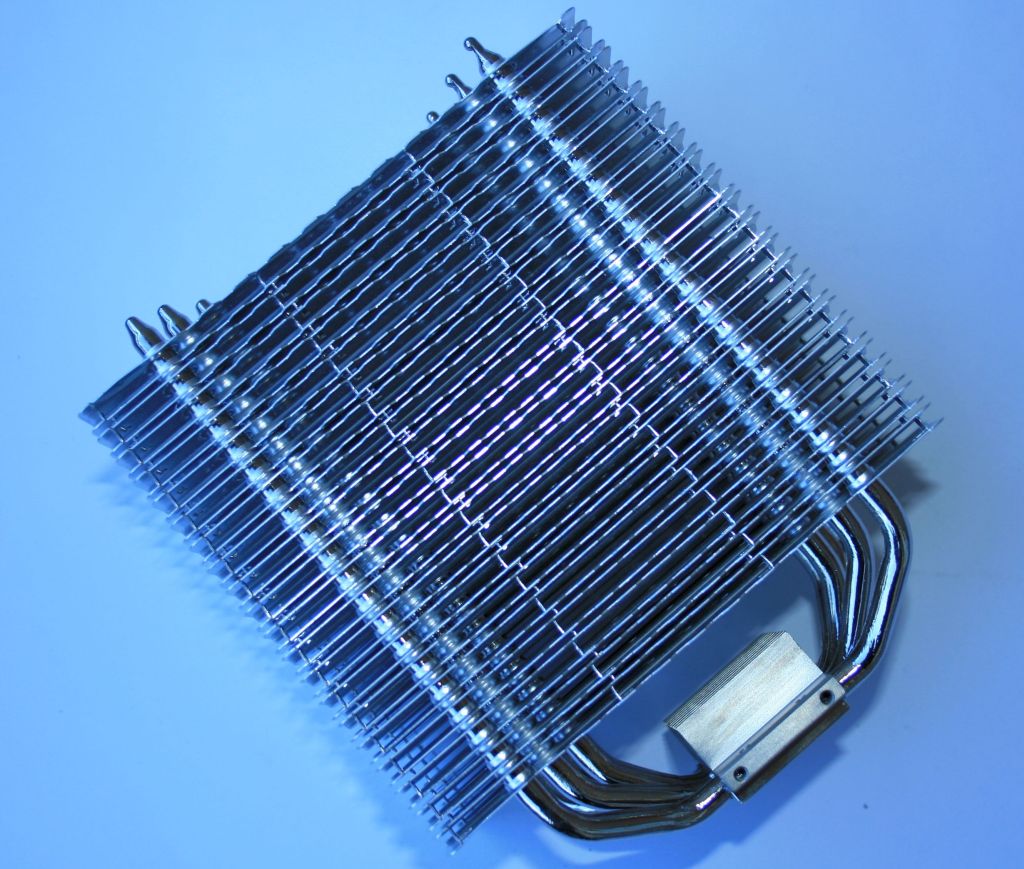
The thickness of each plate is 0.5 mm. The distance between them varies from 1.5 to 3 mm. Each aluminum plate is perforated (the number of holes in the top plate is 67) and together they form a cellular structure. This arrangement of plates is unique, although similar solutions have been encountered by other manufacturers before.
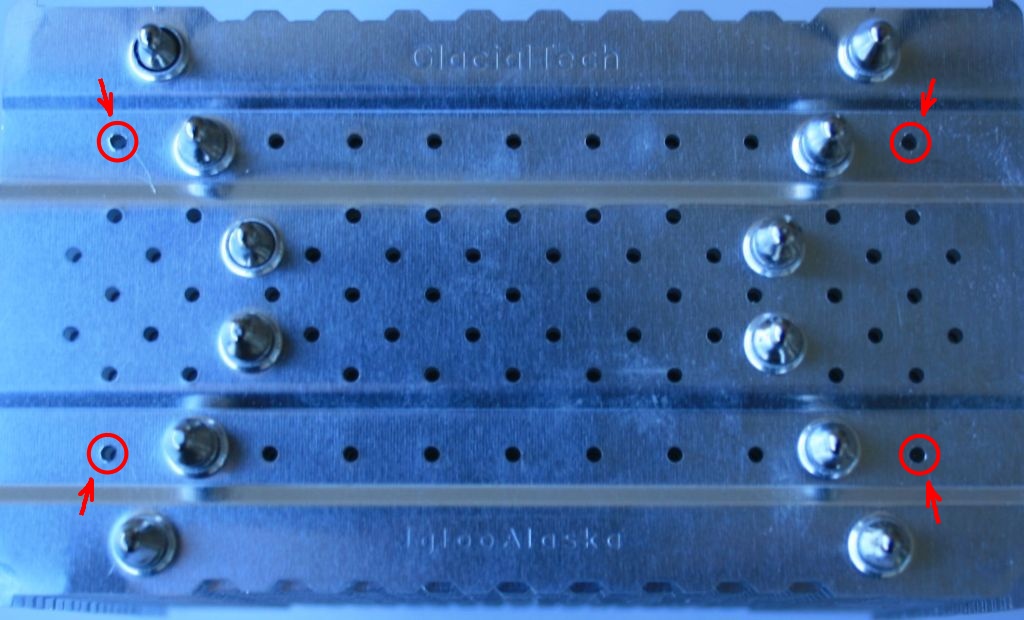
The name of the manufacturer and the model of the cooler are stamped on the top plate. The holes marked in the photo are intended for mounting steel brackets that fix the fan.
Heat pipes are arranged "V" figuratively. This is done for a more uniform distribution of heat on the plate and to ensure that the closer tubes do not block the air flow from the fan for more distant ones.
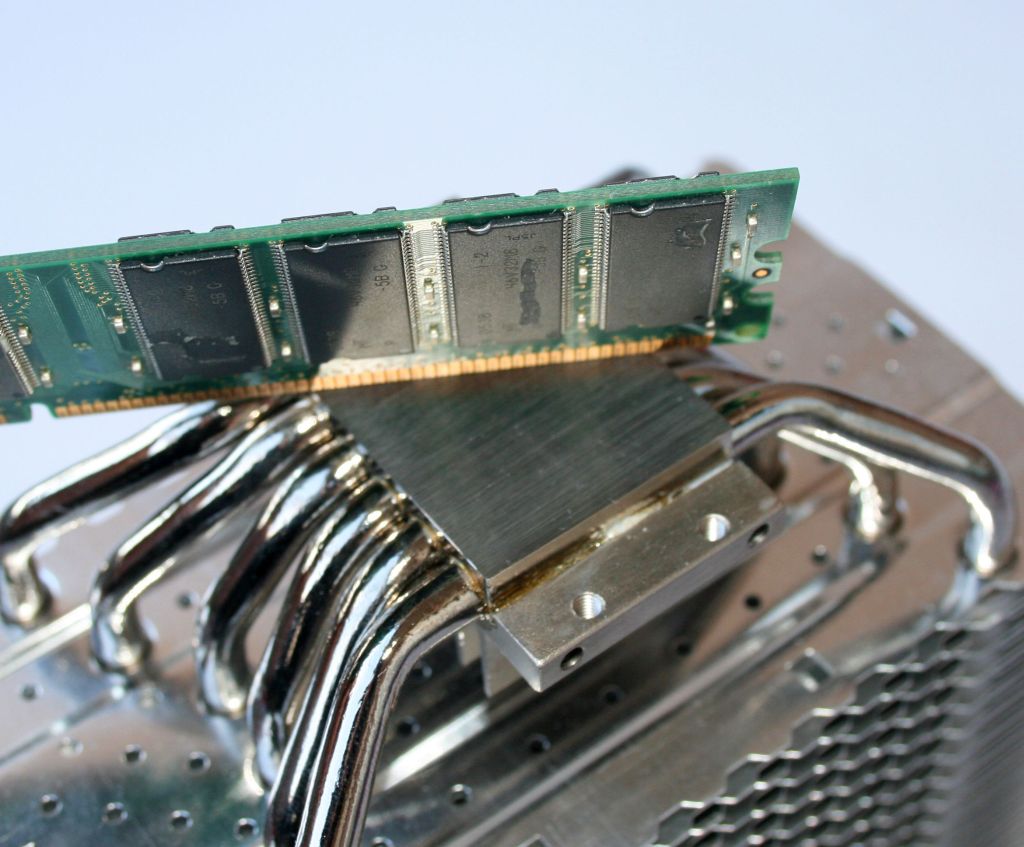
Copper nickel-plated base is equipped with an additional aluminum radiator and has dimensions of 40 x 30 mm. Lots of heat pipes passing through the base, laid in the grooves and soldered. The quality of processing of the base is not at a high level - in this case, it is not only about polishing, but also about grinding. However, it is possible that this is a feature of this sample. After all, the manufacturer's website has a photo with a practically perfectly polished base.
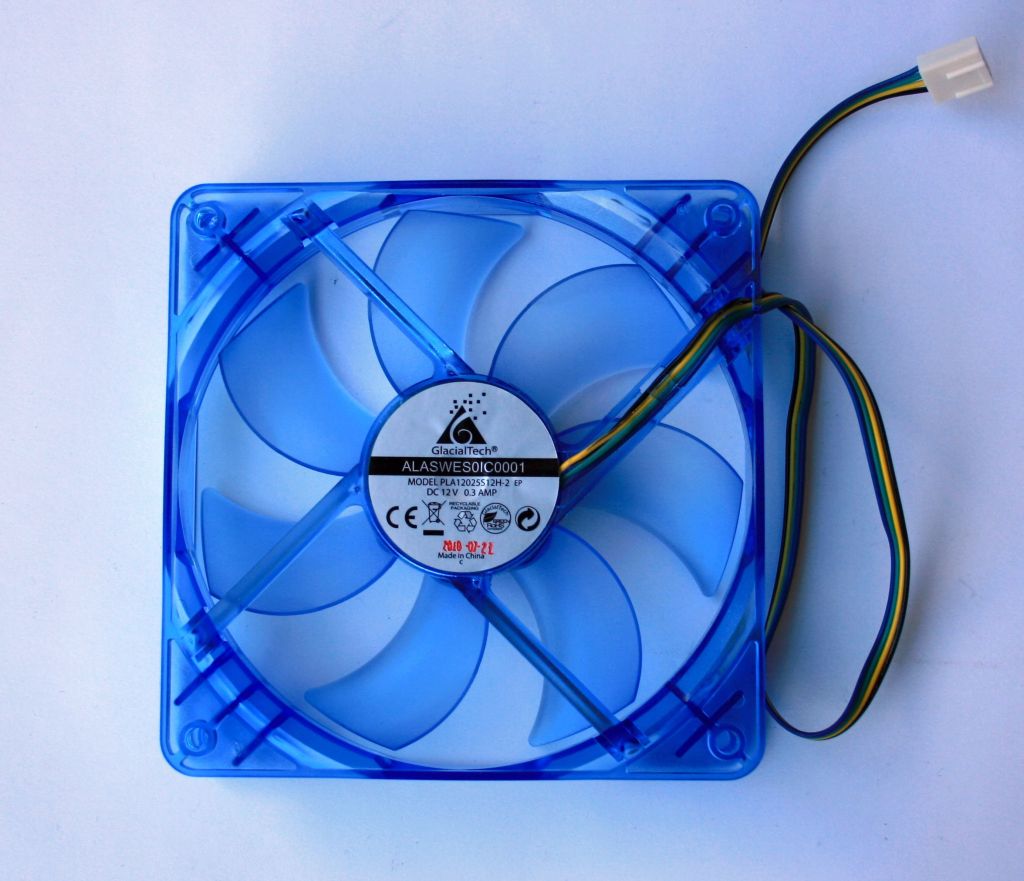
GlacialTech Alaska is equipped with ALASWES0IC001 fan (PLA12025S12H-2 EP) size 120 120 25 mm. The fan has seven blades, the rotation speed of which varies according to the PWM method in the range of 700 (± 300) - 1600 (± 250) rpm.
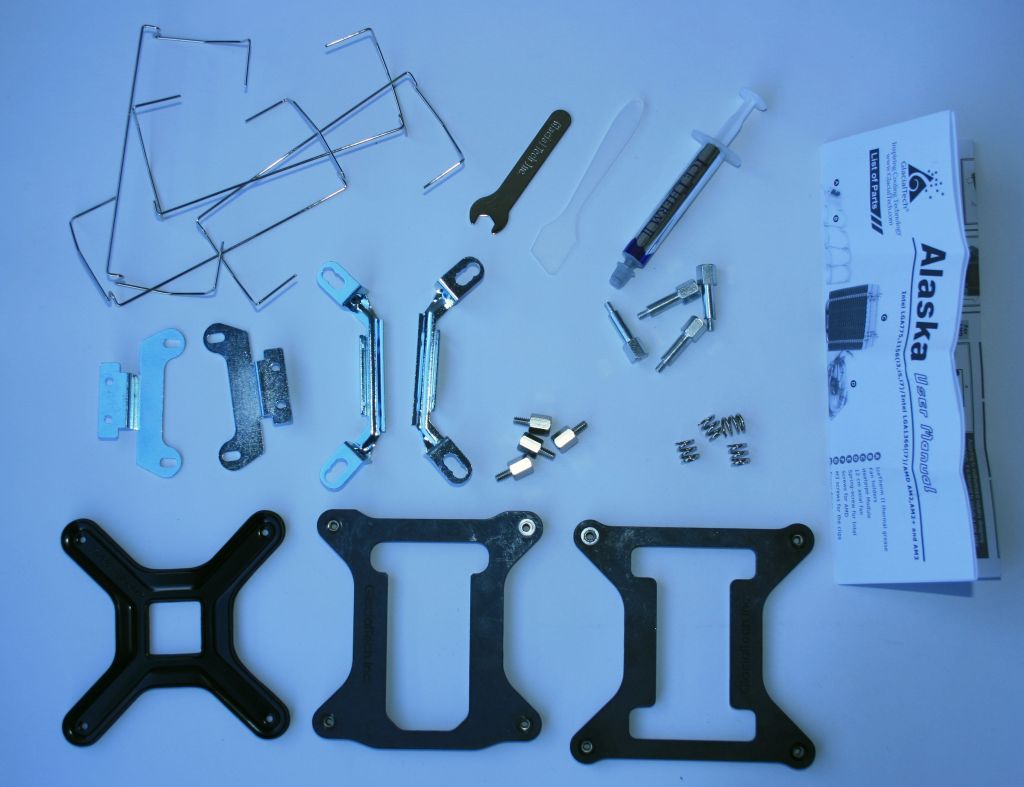
The delivery package includes a mounting kit, four steel brackets for installing the fans, GlacialTech IceTherm II thermal grease, a paddle for its application and a special key for mounting the cooler on the motherboard. The mount kit consists of three reverse plates (for installing the cooler on Intel LGA775, LGA 1156, LGA 1366 motherboards, respectively), two steel plates, fasteners for AMD platforms, and four spring-loaded screws.
')
Test configuration and testing methodology
Processor - Intel Core i5 750 ES (2.67 GHz, Lynnfield, rev. B1)
Motherboard - Asus Maximus III Formula (Intel P55, Intel LGA 1156, BIOS 2001)
RAM - Crucial CT12864BA1339.M8FF, DDR3, 2 x 1024 MB, CL9-9-9-27, 1.5 V
Video Card - Asus GeForce 6600
Power supply - Enermax EMG500AWT (Modu87 +, 500 W)
Hard Drive - WD3202ABYS RE3
Cooling System - GlacialTech Alaska
Testing was conducted in the operating system Windows Vista SP2.
RealTemp 3.60 was used to monitor the temperature, Everest Ultimate Edition 5.50.2100 fan speed was monitored, and Riva Tuner 2.24c was used to graphically display the monitoring. The load was created using the Linpack - LinX 0.6.4 graphical shell for 15 minutes using all the available memory. The Intel Core i5 750 processor was overclocked to the frequency of 3800 MHz with a supply voltage of 1.35 V. The rotation speed of the fan blades was ~ 1650 rpm. Testing was performed on a horizontal open stand. The temperature in the room at the time of testing was 25-26 degrees Celsius.
Test results
After a rather long period of production of not expensive coolers intended for replacement with a box, it seems that GlacialTech has managed to produce a really decent product. After 15 minutes of testing with the LinX utility, the maximum temperature of the hottest core was 74 degrees Celsius. With the recommended Alaska cost of $ 45, we can say that this cooler fulfills its entire cost.

True, I would like to see in modern coolers not a huge set of mounts, designed for each individual platform. Two universal mount designed for installation on Intel and AMD motherboards would have looked much better. I think that the company GlacialTech will finalize in this direction.
According to the test results, GlacialTech Alaska receives the Editor's Choice award.


GlacialTech Alaska CPU cooler comes in a cardboard box made with white and blue colors, equipped with a plastic handle for easy carrying.

On the front side of which there is an image of the cooler itself, a snowboarder symbolizing power and cold, as well as information about compatible platforms Intel LGA 775/1156/1366 and AMD AM2 / AM2 + / AM3.



On the side walls of the box and its back side, there is information about the technical characteristics, key features of the cooler and a list of contacts with the manufacturer. Also, this information can be found on the official website of the company GlacialTech.

Inside the packing box, we find a radiator, a set of fasteners in a separate plastic bag, a fan in a small additional box and installation instructions. All components are fixed securely and problems during transportation should not arise.

The radiator has dimensions of 130 x 101 x 156 mm. Its weight is 740 grams. The “body” of the radiator is based on six copper nickel-plated heat pipes with a diameter of 6 mm, on which 40 aluminum plates are strung.

The thickness of each plate is 0.5 mm. The distance between them varies from 1.5 to 3 mm. Each aluminum plate is perforated (the number of holes in the top plate is 67) and together they form a cellular structure. This arrangement of plates is unique, although similar solutions have been encountered by other manufacturers before.

The name of the manufacturer and the model of the cooler are stamped on the top plate. The holes marked in the photo are intended for mounting steel brackets that fix the fan.
Heat pipes are arranged "V" figuratively. This is done for a more uniform distribution of heat on the plate and to ensure that the closer tubes do not block the air flow from the fan for more distant ones.

Copper nickel-plated base is equipped with an additional aluminum radiator and has dimensions of 40 x 30 mm. Lots of heat pipes passing through the base, laid in the grooves and soldered. The quality of processing of the base is not at a high level - in this case, it is not only about polishing, but also about grinding. However, it is possible that this is a feature of this sample. After all, the manufacturer's website has a photo with a practically perfectly polished base.

GlacialTech Alaska is equipped with ALASWES0IC001 fan (PLA12025S12H-2 EP) size 120 120 25 mm. The fan has seven blades, the rotation speed of which varies according to the PWM method in the range of 700 (± 300) - 1600 (± 250) rpm.

The delivery package includes a mounting kit, four steel brackets for installing the fans, GlacialTech IceTherm II thermal grease, a paddle for its application and a special key for mounting the cooler on the motherboard. The mount kit consists of three reverse plates (for installing the cooler on Intel LGA775, LGA 1156, LGA 1366 motherboards, respectively), two steel plates, fasteners for AMD platforms, and four spring-loaded screws.
')
Test configuration and testing methodology
Processor - Intel Core i5 750 ES (2.67 GHz, Lynnfield, rev. B1)
Motherboard - Asus Maximus III Formula (Intel P55, Intel LGA 1156, BIOS 2001)
RAM - Crucial CT12864BA1339.M8FF, DDR3, 2 x 1024 MB, CL9-9-9-27, 1.5 V
Video Card - Asus GeForce 6600
Power supply - Enermax EMG500AWT (Modu87 +, 500 W)
Hard Drive - WD3202ABYS RE3
Cooling System - GlacialTech Alaska
Testing was conducted in the operating system Windows Vista SP2.
RealTemp 3.60 was used to monitor the temperature, Everest Ultimate Edition 5.50.2100 fan speed was monitored, and Riva Tuner 2.24c was used to graphically display the monitoring. The load was created using the Linpack - LinX 0.6.4 graphical shell for 15 minutes using all the available memory. The Intel Core i5 750 processor was overclocked to the frequency of 3800 MHz with a supply voltage of 1.35 V. The rotation speed of the fan blades was ~ 1650 rpm. Testing was performed on a horizontal open stand. The temperature in the room at the time of testing was 25-26 degrees Celsius.
Test results
After a rather long period of production of not expensive coolers intended for replacement with a box, it seems that GlacialTech has managed to produce a really decent product. After 15 minutes of testing with the LinX utility, the maximum temperature of the hottest core was 74 degrees Celsius. With the recommended Alaska cost of $ 45, we can say that this cooler fulfills its entire cost.

True, I would like to see in modern coolers not a huge set of mounts, designed for each individual platform. Two universal mount designed for installation on Intel and AMD motherboards would have looked much better. I think that the company GlacialTech will finalize in this direction.
According to the test results, GlacialTech Alaska receives the Editor's Choice award.

Source: https://habr.com/ru/post/108323/
All Articles